By Fennie | 12 August 2020 | 2 Comments
How Many Do You Know About LCD Screen and OLED Screen?
A small mobile phone has big use. This communication tool that was once only used to calls someone is now omnipotent and has become the first window for people to connect to the entire world.
The mobile phone screen is responsible for the display function of the mobile phone and the entrance of touch operation. It is also the "window of the window" and its status is very important.
How many do you know about the LCD screen and OLED screen? Read our blog, you will have a more comprehensive understanding of LCD screen and OLED screen.
If you look at the mobile phone posters, you will find that there are many different languages about screen materials and technology: TFT LCD, TFT, IPS, LTPS, OLED, AMOLED, etc., which are dazzling.
What are the different screens using these technologies, and what are the advantages and disadvantages?
In fact, the current mainstream mobile phone screens are classified in terms of technology, and they are nothing more than LCD and OLED.
LCD: The English full name is Liquid Crystal Display, which is actually the famous liquid crystal display.
OLED: English full name Organic Light-Emitting Diode.
The three primary colors of light are red, green and blue, and by mixing these three colors in different proportions, you can get almost all the colors in nature. Therefore, each pixel on the mobile phone screen is also composed of a mixture of these three colors.
The figure below is a vertical section view of each pixel under LCD and OLED technology, showing the principle of light emission of this pixel.
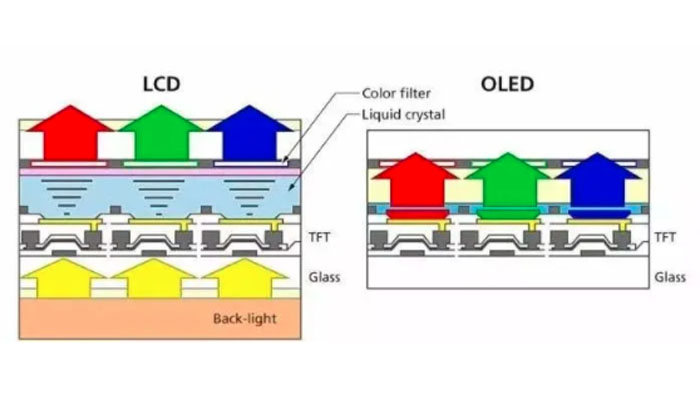
In LCD technology, although the word "liquid crystal (the Liquid Crystal on the left in the picture above)" is very conspicuous, the liquid crystal does not emit light. A backplane composed of LEDs (light emitting diodes) is needed to provide a white light source. Also called "Backlight (Back-light in the picture above)".
On the basis of the backlight for each pixel, add a layer of red, green, and blue films. White light passes through these films and becomes colored light of red, green, and blue.
But if the intensities of these three kinds of light are the same, they will become white or gray when mixed. Therefore, it must be flexible control of the intensity of each light to mix multiple colors.
At this time, it is turn off the liquid crystal material to appear. Liquid crystal has a characteristic, that is, under the action of an electric field, its molecular arrangement will change, thereby affecting the light permeability, changing the voltage can adjust the amount of light transmitted.
For LCD screens, the liquid crystal layer sandwiched between the backlight and the film adjusts the light that can pass through by adjusting the input voltage. After passing through the colored film, you can get the three primary colors of different intensities. After mixing, it will be varied. Color up.
So, how to adjust the input voltage of each pixel?
The so-called TFT (Thin film transistor) refers to the thin film transistor array on the glass substrate of the liquid crystal panel, which allows each pixel of the LCD to be equipped with its own semiconductor switch, thereby achieving independent and precise control of "point-to-point".
Therefore, the mainstream LCD screen is also called TFT-LCD. However, IPS and LTPS are actually implemented by different technologies under TFT-LCD, so I won't repeat them here.
Now it's talk about OLED screen
The structure of the OLED screen is much simpler than LCD. It does not require a backlight, nor does it have a liquid crystal or color filter film. The internal organic material coating is like a small colored light bulb, which can emit light when powered on.
AMOLED: Everyone already knows about OLED. The previous AM refers to the driving method of OLED. Its full name is Active Matrix, which is active matrix. TFT is usually used as a switch to control the current through organic materials to achieve different colors. All OLEDs currently used in mobile phones are AMOLED, so we can think of them as the same one.
Super AMOLED: Samsung’s improvement to AMOLED, canceled the middle touch sensor panel, and made the AMOLED sensor layer on the screen, so the control is more sensitive, slimmer, brighter, and the presentation effect is better in the sun .
Dynamic AMOLED: It is also the AMOLED improved technology launched by Samsung, currently mainly used in high-end devices, like iPhone 11 Pro. This technology changes the organic materials in OLEDs, and it is said to achieve a wider dynamic range. When the image contrast is high, it can display more dark details.
In essence, super AMOLED and dynamic AMOLED are mostly gimmicks. They all belong to AMOLED, and AMOLED is the OLED technology for mobile phones.
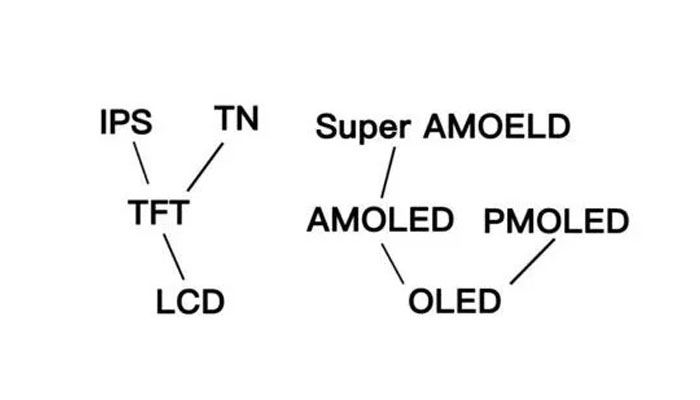
Compared with OLED screens, LCD screens have many disadvantages.
1. Cannot display black: Because the liquid crystal layer cannot be completely closed, some backlight will always pass through, so the LCD cannot display pure black, only dark gray. And OLED can realize pure black display by controlling the switch of each pixel.

2. Easy to leak light: The backlight of the LCD screen can easily leak from the screen and the frame of the mobile phone, forming a light leakage phenomenon. This phenomenon is common in the era of rough mobile phone workmanship, and it is rarely seen now.
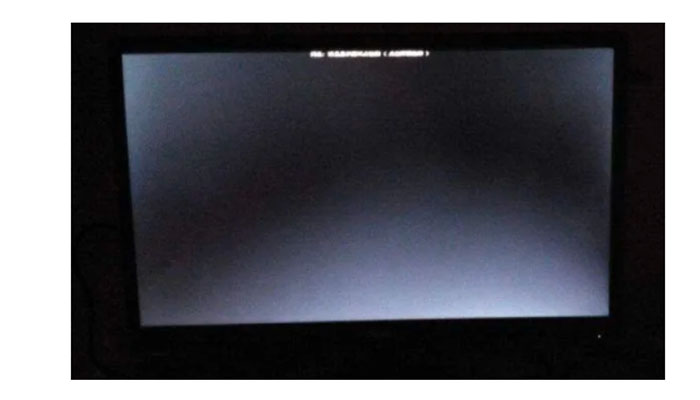
3. Large screen thickness: LCD is limited by the backlight layer and liquid crystal layer due to its complex technology, and the screen thickness is much larger than that of OLED. Of course, this thickness is not worth mentioning on the TV, but in the mobile phone, where the pursuit of slimness and extremely limited internal space, the screen is thinner, and more other components can be plugged in to improve other aspects performance.
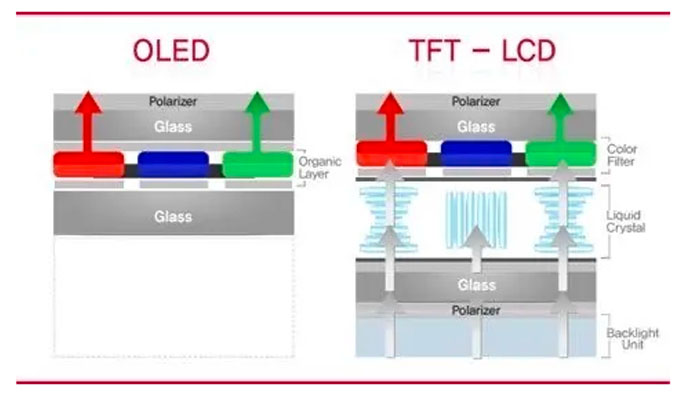
4. It is difficult to realize a curved screen: LCD cannot be bent greatly, while OLED is no any problem. Therefore, for those mobile phones like curved screens, only OLED screens can be used.
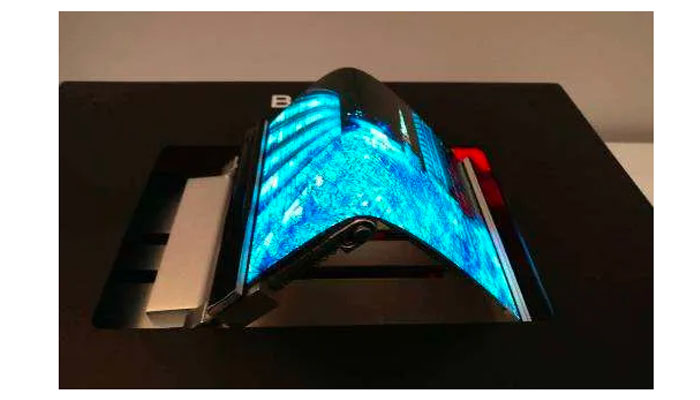
5. Large power consumption: Since the LCD screen has a backlight, it must be fully lit during use, and OLED can individually control the switch of each pixel, so the power consumption of the LCD screen is much greater than OLED. In the picture below, JMGO R1 and Xiaomi mix2s are both LCD screens, and battery life is obviously at a disadvantage under long-term video playback.
6.Long response time: Due to the long response time of the LCD screen, smearing will occur when the screen slides quickly. The OLED responds quickly, clean and without smear.
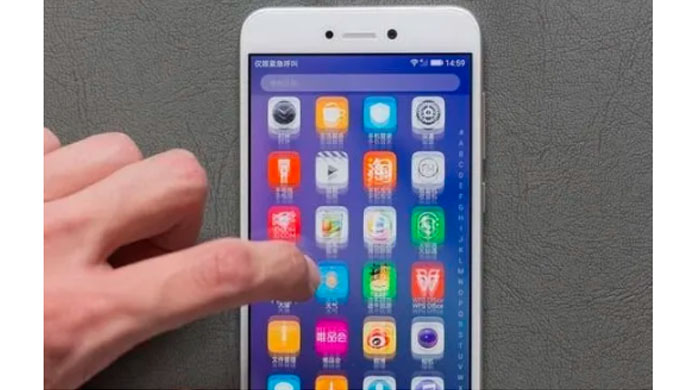
Having said so many shortcomings of LCD, is OLED perfect? Of course not. OLEDs mainly suffer from burn-in and stroboscopic issues.
1. Screen burn-in: As the organic materials used in OLED screens age quickly, if some pixels have a heavy workload and some are relatively idle, there will be a problem of inconsistent aging of the entire screen, resulting in color display in different areas A deviation occurred. This phenomenon is called burn-in.
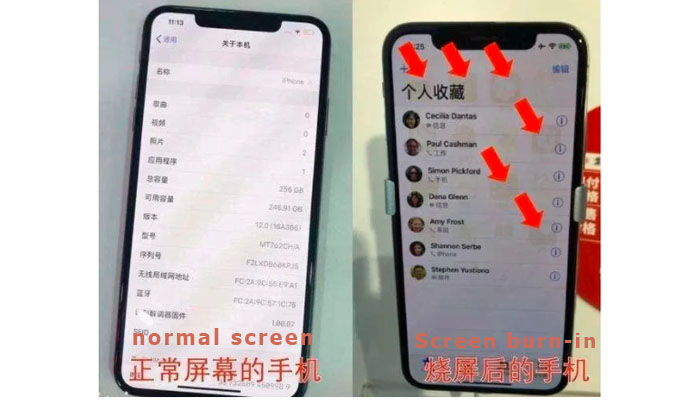
However, under normal use, screen burning is a slow process. Three years have passed when it is obvious that most people should change their phones.
Burn-in is a shortcoming of OLED screens. For LCD, the backlight is completely lit, and the LCD has a longer aging time, so there is basically no problem of burn-in.
2. Screen Flicker: For LCD, to control the screen brightness, you can directly adjust the brightness of the backlight. But OLED is more troublesome. It needs to switch the screen at high frequency to achieve dimming. If you want to brighten, turn on the screen more times, and if you want to dim, turn off the screen more times.

Since the time of switching the screen each time is very short, although the human eye can hardly detect the change of the screen each time, it can feel the average brightness and darkness over a period of time, thus achieving the effect of dimming.
For example, to achieve 50% brightness, it takes half the time to turn on the screen and half the time to turn off the screen. At lower brightness, it takes longer to turn off the screen. The screen flashes and flashes, and it can even be visible to the naked eye. The point: the eyes can't tell the uncomfortable.
This phenomenon of OLED is called screen flicker, hence the name "eye-damaging screen". In contrast, LCD screens generously call themselves "eye protection screens."
Although there are shortcomings, the shortcomings do not conceal the advantages. At present, OLED screens have entered the mainstream, gradually compressing the living space of LCD screens, which is especially obvious on high-end machines.
For this, we can get something of Apple's configuration.
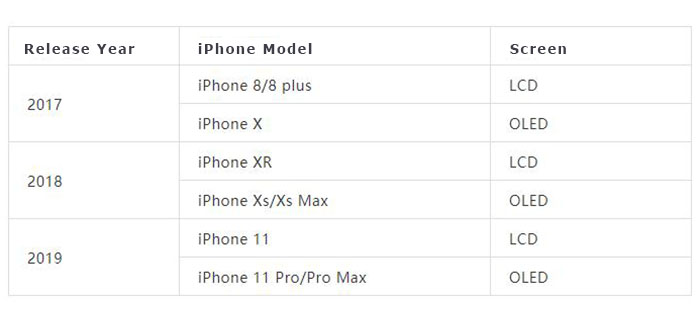
It can be seen from the above that from the iPhone X series, OLED screens are used for products with high positioning, and LCD screens are used for low price products.
Recently, there is a hot sale JK iPhone X OLED aftermarket incell screen replacement in market. Compare with other iPhone screen replacement, JK high-end OLED incell screen have features below:
* Perfectly solved the black screen issue when under polarized sunglasses at all angles.
* Perfect installation experience with iPhone housing.
* JK flexible OLED screen has better brightness and color saturation compare with other aftermarket OLED screen.
* JK's iPhone OLED flexible screen's hydrophobic effect test works perfectly.
The mobile phone screen is responsible for the display function of the mobile phone and the entrance of touch operation. It is also the "window of the window" and its status is very important.
How many do you know about the LCD screen and OLED screen? Read our blog, you will have a more comprehensive understanding of LCD screen and OLED screen.
If you look at the mobile phone posters, you will find that there are many different languages about screen materials and technology: TFT LCD, TFT, IPS, LTPS, OLED, AMOLED, etc., which are dazzling.
What are the different screens using these technologies, and what are the advantages and disadvantages?
In fact, the current mainstream mobile phone screens are classified in terms of technology, and they are nothing more than LCD and OLED.
LCD: The English full name is Liquid Crystal Display, which is actually the famous liquid crystal display.
OLED: English full name Organic Light-Emitting Diode.
The three primary colors of light are red, green and blue, and by mixing these three colors in different proportions, you can get almost all the colors in nature. Therefore, each pixel on the mobile phone screen is also composed of a mixture of these three colors.
The figure below is a vertical section view of each pixel under LCD and OLED technology, showing the principle of light emission of this pixel.

In LCD technology, although the word "liquid crystal (the Liquid Crystal on the left in the picture above)" is very conspicuous, the liquid crystal does not emit light. A backplane composed of LEDs (light emitting diodes) is needed to provide a white light source. Also called "Backlight (Back-light in the picture above)".
On the basis of the backlight for each pixel, add a layer of red, green, and blue films. White light passes through these films and becomes colored light of red, green, and blue.
But if the intensities of these three kinds of light are the same, they will become white or gray when mixed. Therefore, it must be flexible control of the intensity of each light to mix multiple colors.
At this time, it is turn off the liquid crystal material to appear. Liquid crystal has a characteristic, that is, under the action of an electric field, its molecular arrangement will change, thereby affecting the light permeability, changing the voltage can adjust the amount of light transmitted.
For LCD screens, the liquid crystal layer sandwiched between the backlight and the film adjusts the light that can pass through by adjusting the input voltage. After passing through the colored film, you can get the three primary colors of different intensities. After mixing, it will be varied. Color up.
So, how to adjust the input voltage of each pixel?
The so-called TFT (Thin film transistor) refers to the thin film transistor array on the glass substrate of the liquid crystal panel, which allows each pixel of the LCD to be equipped with its own semiconductor switch, thereby achieving independent and precise control of "point-to-point".
Therefore, the mainstream LCD screen is also called TFT-LCD. However, IPS and LTPS are actually implemented by different technologies under TFT-LCD, so I won't repeat them here.
Now it's talk about OLED screen
The structure of the OLED screen is much simpler than LCD. It does not require a backlight, nor does it have a liquid crystal or color filter film. The internal organic material coating is like a small colored light bulb, which can emit light when powered on.
AMOLED: Everyone already knows about OLED. The previous AM refers to the driving method of OLED. Its full name is Active Matrix, which is active matrix. TFT is usually used as a switch to control the current through organic materials to achieve different colors. All OLEDs currently used in mobile phones are AMOLED, so we can think of them as the same one.
Super AMOLED: Samsung’s improvement to AMOLED, canceled the middle touch sensor panel, and made the AMOLED sensor layer on the screen, so the control is more sensitive, slimmer, brighter, and the presentation effect is better in the sun .
Dynamic AMOLED: It is also the AMOLED improved technology launched by Samsung, currently mainly used in high-end devices, like iPhone 11 Pro. This technology changes the organic materials in OLEDs, and it is said to achieve a wider dynamic range. When the image contrast is high, it can display more dark details.
In essence, super AMOLED and dynamic AMOLED are mostly gimmicks. They all belong to AMOLED, and AMOLED is the OLED technology for mobile phones.

Compared with OLED screens, LCD screens have many disadvantages.
1. Cannot display black: Because the liquid crystal layer cannot be completely closed, some backlight will always pass through, so the LCD cannot display pure black, only dark gray. And OLED can realize pure black display by controlling the switch of each pixel.

2. Easy to leak light: The backlight of the LCD screen can easily leak from the screen and the frame of the mobile phone, forming a light leakage phenomenon. This phenomenon is common in the era of rough mobile phone workmanship, and it is rarely seen now.

3. Large screen thickness: LCD is limited by the backlight layer and liquid crystal layer due to its complex technology, and the screen thickness is much larger than that of OLED. Of course, this thickness is not worth mentioning on the TV, but in the mobile phone, where the pursuit of slimness and extremely limited internal space, the screen is thinner, and more other components can be plugged in to improve other aspects performance.

4. It is difficult to realize a curved screen: LCD cannot be bent greatly, while OLED is no any problem. Therefore, for those mobile phones like curved screens, only OLED screens can be used.

5. Large power consumption: Since the LCD screen has a backlight, it must be fully lit during use, and OLED can individually control the switch of each pixel, so the power consumption of the LCD screen is much greater than OLED. In the picture below, JMGO R1 and Xiaomi mix2s are both LCD screens, and battery life is obviously at a disadvantage under long-term video playback.
6.Long response time: Due to the long response time of the LCD screen, smearing will occur when the screen slides quickly. The OLED responds quickly, clean and without smear.

Having said so many shortcomings of LCD, is OLED perfect? Of course not. OLEDs mainly suffer from burn-in and stroboscopic issues.
1. Screen burn-in: As the organic materials used in OLED screens age quickly, if some pixels have a heavy workload and some are relatively idle, there will be a problem of inconsistent aging of the entire screen, resulting in color display in different areas A deviation occurred. This phenomenon is called burn-in.

However, under normal use, screen burning is a slow process. Three years have passed when it is obvious that most people should change their phones.
Burn-in is a shortcoming of OLED screens. For LCD, the backlight is completely lit, and the LCD has a longer aging time, so there is basically no problem of burn-in.
2. Screen Flicker: For LCD, to control the screen brightness, you can directly adjust the brightness of the backlight. But OLED is more troublesome. It needs to switch the screen at high frequency to achieve dimming. If you want to brighten, turn on the screen more times, and if you want to dim, turn off the screen more times.

Since the time of switching the screen each time is very short, although the human eye can hardly detect the change of the screen each time, it can feel the average brightness and darkness over a period of time, thus achieving the effect of dimming.
For example, to achieve 50% brightness, it takes half the time to turn on the screen and half the time to turn off the screen. At lower brightness, it takes longer to turn off the screen. The screen flashes and flashes, and it can even be visible to the naked eye. The point: the eyes can't tell the uncomfortable.
This phenomenon of OLED is called screen flicker, hence the name "eye-damaging screen". In contrast, LCD screens generously call themselves "eye protection screens."
Although there are shortcomings, the shortcomings do not conceal the advantages. At present, OLED screens have entered the mainstream, gradually compressing the living space of LCD screens, which is especially obvious on high-end machines.
For this, we can get something of Apple's configuration.

It can be seen from the above that from the iPhone X series, OLED screens are used for products with high positioning, and LCD screens are used for low price products.
Recently, there is a hot sale JK iPhone X OLED aftermarket incell screen replacement in market. Compare with other iPhone screen replacement, JK high-end OLED incell screen have features below:
* Perfectly solved the black screen issue when under polarized sunglasses at all angles.
* Perfect installation experience with iPhone housing.
* JK flexible OLED screen has better brightness and color saturation compare with other aftermarket OLED screen.
* JK's iPhone OLED flexible screen's hydrophobic effect test works perfectly.
Recently Reviews
Read MoreLeave a Reply
Your email address will not be published.Required fields are marked. *
POPULAR BLOG
- How to Fix iPhone Xr Dim Backlight - Repair With New Backlight Module
- Aftermarket iPhone X Series Touch Issue After Screen Replacement Explained
- How to Fix iPhone X Ear Speaker No Working - Jump Wire Solution
- How to Fix iPhone With A Screw - Apple Wallet Payment Failure
- How to Fix iPhone 11 Touch Screen Not Working - Step by Step
ARCHIVES
CATEGORIES